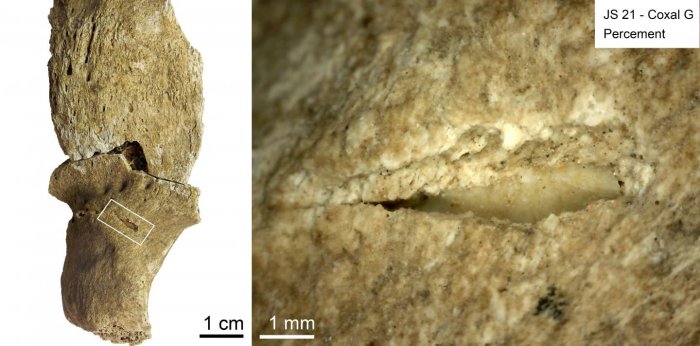Conny Waters – AncientPages.com – Since its discovery in the 1960s, the Jebel Sahaba cemetery (Nile Valley, Sudan), 13 millennia old, was considered to be one of the oldest testimonies to prehistoric warfare.

Projectile impact puncture with an embedded lithic fragment in the posterior surface of the left hip bone of individual JS 21. Credit: Isabelle Crevecoeur/Marie-Hélène Dias-Meirinho
Now, scientists from the CNRS and the University of Toulouse – Jean Jaurès have re-analyzed the bones preserved in the British Museum (London) and re-evaluated their archaeological context.
The results show that it was not a single armed conflict but rather a succession of violent episodes, probably exacerbated by climate change.
Reanalysis of the prehistoric cemetery Jebel Sahaba (Sudan), one of the earliest sites showing human warfare (13,400 years ago), suggests that hunter-fisher-gatherers engaged in repeated, smaller conflicts. Healed trauma on the skeletons found in the cemetery indicates that individuals fought and survived several violent ᴀssaults, rather than fighting in one fatal event as previously thought.
Isabelle Crevecoeur and colleagues reanalyzed the skeletal remains of 61 individuals, who were originally excavated in the 1960s, using newly available microscopy techniques. The authors identified 106 previously undocumented lesions and traumas and were able to distinguish between projectile injuries (from arrows or spears), trauma (from close combat), and traces ᴀssociated with natural decay.
They found 41 individuals (67%) buried in Jebel Sahaba had at least one type of healed or unhealed injury. Of the 41 individuals with injuries, 92% had evidence of these being caused by projectiles and close combat trauma, suggesting interpersonal acts of violence.
The authors suggest that the number of healed wounds matches sporadic and recurrent acts of violence, which were not always lethal, between Nile valley groups at the end of the Late Pleistocene (126,000 to 11,700 years ago).
These may have been repeated skirmishes or raids between different groups.
At least half of the injuries were identified as puncture wounds, caused by projectiles like spears and arrows, which supports the authors’ theory that these injuries happened when groups attacked from a distance, rather than during domestic conflicts.
Source
Written by Conny Waters – AncientPages.com Staff Writer





